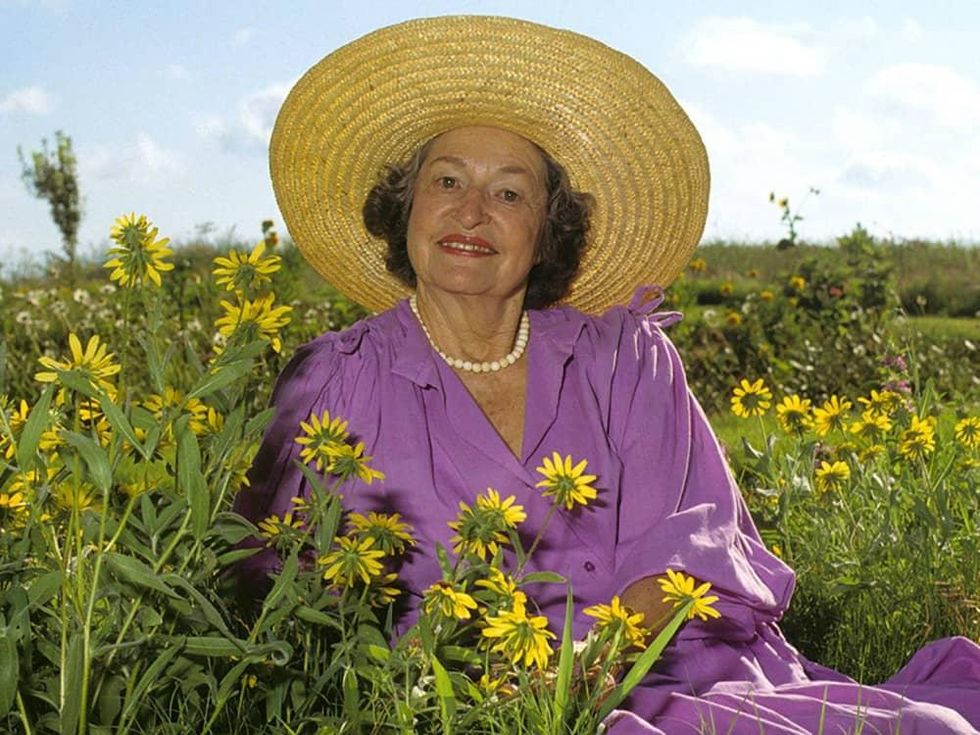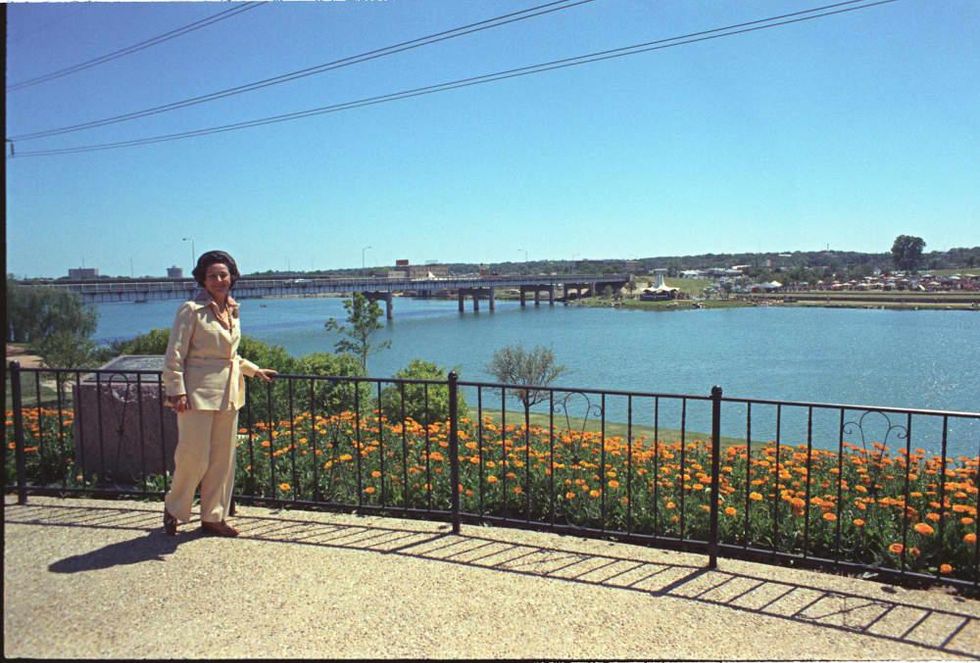History of Austin
The beautiful history of Lady Bird Johnson and how she forever changed Austin
The history of Lady Bird Johnson begins in the tiny East Texas town of Karnack. Born three days before Christmas 1912, Claudia Alta Taylor was a curious, nature-loving child nicknamed "Lady Bird" by her nanny who thought she was "as purty as a Lady Bird." The apt nickname stayed with her throughout her lifetime.
Lady Bird graduated from Marshall High School in 1928 before attending junior college in Dallas from 1928 to 1930. Though she had considered attending college in Alabama, when a friend decided to go to the University of Texas at Austin, Lady Bird followed her lead.
As has been largely reported for decades, as her plane landed in the Capital City, Lady Bird spotted a field of bluebonnets and instantly fell in love with the area. The future first lady graduated in 1934 with diplomas in both journalism and history.
Later that year, fate intervened when Lady Bird met Lyndon Baines Johnson, who was visiting Austin in a business capacity as a congressional aide.
A whirlwind courtship
The pair had their first official date over breakfast at the Driskill Hotel in downtown Austin. The remainder of the day was spent driving through Austin and the winding Texas Hill Country.
In the two-and-a-half months following their first date, Lyndon was an ardent suitor, bombarding Lady Bird (or "Bird" as he called her) with constant romantic letters.
In November of 1934, just weeks after their first date, Lyndon traveled to the Piney Woods of East Texas and proposed to Lady Bird. They married in San Antonio the next day on November 17, 1934, using a $2.50 ring Lyndon had purchased from Sears. And although the minister who married them had strong doubts about the union, it lasted until Lyndon's death in 1973.
The couple finally had two daughters, Lynda Bird, born in 1944, and Luci Baines, born in 1947, after experiencing three miscarriages. Including with the famous Johnson beagles, they all share the initials LBJ.
The LBJ's head to D.C.
The duo frequently drove from Texas to Washington, and as they did, Lady Bird became increasingly alarmed at the blight that was America's roadways. Once in office, first as vice president from 1961 to 1963 before becoming president from 1963 to 1969, Lyndon focused on his Great Society initiatives, while the first lady was determined to improve U.S. highways by planting wildflowers and attractive landscapes throughout the country.
Among Lady Bird's marquee achievements was the Highway Beautification Act in 1965. A somewhat controversial bill, it "called for control of outdoor advertising, including removal of certain types of signs, along the nation's growing interstate system," according to the Department of Transportation. "It also required certain junkyards along interstate or primary highways to be removed or screened and encouraged scenic enhancement and roadside development."
The bill hit roadblocks before its passage, thanks to Congressional Republicans intent on killing it. According to the LBJ Presidential Library, Lyndon reportedly told his staff, "The Congress is about ready to adjourn, and they haven't passed Lady Bird's Highway Beautification Act. ... Now, she wants that bill. And if she wants it, I want it, and by God, we're going to pass it."
Although Lyndon was brash and bold, many viewed Lady Bird as a powerful influence on her husband — and rightfully so. The act passed in 1965, limiting billboards on roadsides and providing funding for beautification projects across the land.
While in D.C., Lady Bird formed the First Lady's Committee for a More Beautiful Capital. She ultimately added cherry tree blossoms on the National Mall and reenacted the original 1912 Japanese tree planting at the 1965 Cherry Blossom Festival in the nation's capital.
During his presidential tenure, the Johnson family, along with the press corps, would visit the Johnson Ranch, also known as the Texas White House, in Stonewall, Texas. When the press covered the 35th president, they stayed at a local motor lodge. The lodge has since been revamped, combining a "retro" vibe with modern amenities and converted into newly reopened Stonewall Motor Lodge. There is even an official room at the lodge named after the press corps.
Once in the Hill Country, the Johnsons could enjoy the serenity of Texas wildflowers, wildlife, trails, and creeks. This area was where the former president was born, and both Lady Bird and Lyndon are buried under the live oaks, as part of the Johnson Cemetery, at the ranch.
At the end of his presidential term, with the unpopular Vietnam War raging, and Lyndon in ill health, Lady Bird urged her husband not to seek a second term. He heeded her advice, and the Johnson family packed their bags and returned to Texas.
From Capitol to the Capital City
Although Lady Bird still spent time at the Johnson Ranch, and in D.C. supporting new administrations, she remained dedicated to beautifying Austin. In the 1970s, a select group was formed to spearhead the Town Lake Beautification Project, later renamed Lady Bird Lake following her death.
"The environment is where we all meet, where we have a mutual interest; it is the one thing all of us share," Lady Bird said in a 1967 speech. "It is not only a mirror of ourselves, but a focusing lens on what we can become."
Lady Bird played a vital role in the project, and the group added the gazebo, additional trees and shrubs, and even a fountain commemorating the bicentennial year (1976), all on Auditorium Shores.
Today, the trail is maintained by members of The Trail Foundation, who continue Lady Bird's work."Lady Bird Johnson and her group had a progressive vision," says TTF director Heidi Anderson. "It is our honor at The Trail Foundation to continue that legacy and to protect and enhance this beloved space."
Before Lyndon's death on his ranch in 1973, he and Lady Bird were instrumental in overseeing the construction of the LBJ Library and Museum, part of the UT System. After his death, Lady Bird continued to play a vital role for the library in contributing papers and serving as a representative.
In 1982, Lady Bird and actress Helen Hayes joined forces in establishing the National Wildlife Research Center in Southwest Austin. Now known as the Lady Bird Johnson Wildflower Center, the center is devoted to "inspiring the preservation of native plants," and serves the public through educational talks, lectures, and fundraising events, as well as a venue for special events.
Toward the end of her life, Lady Bird spent more time with her family in Austin, purchasing a home in Westlake Hills surrounded by nature with an impeccable view of the lake she lovingly improved.
Lady Bird died in 2007 at the age of 94, but her contribution to the nation's roadways, the environment, and Austin continues on today.


